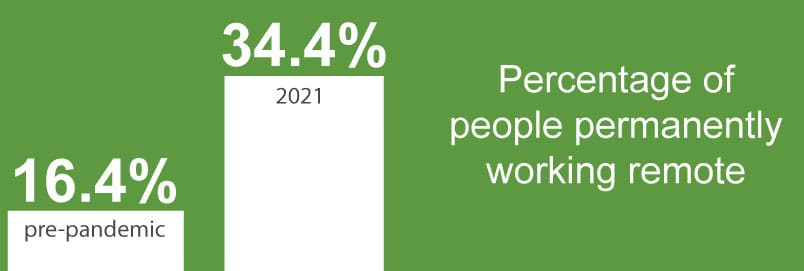With the nationwide vaccination rate of adults now above 50%, more of the workforce is making the transition back into the office of their workplace, yet many others will continue to remain working remote, and the proportion of people working permanently remote is expected to double. Managing a remote workforce is nothing new, however, managing a mix of both office-based and remote workers simultaneously is a new challenge many companies are now beginning to face. Whether you’re looking to modify your workplace policies or start thinking about your company’s culture, here’s a few questions to help identify what things you might want to consider.
Do your remote workers have access to the resources they need?
In addition to the usual technology and IT infrastructure needed for them to have fast internet access and company files, remote workers need access to things like project management tools or messaging platforms like Teams or Slack to stay current on project updates and have multiple ways to contact coworkers when things change. Remote work lacks the convenience of 5 minute standing meetings, or the causal walk down the hallway to a colleague’s cube, so it’s best to have more than one way for those working remotely to get in front of others. Since communication tools are only effective if they’re actually being used, it’s now even more important for all employees (including those in the office) to use these tools consistently so those who are remote are not excluded from conversations.
Are there processes in place to ensure remote workers feel included?
No one intends for remote workers to feel left out, however, it’s an easy feeling to have develop without practices in place to deal with the issue pro-actively. Company events and rituals such as birthday celebrations or special events can be modified to include your remote staff. Keeping up a regular cadence of department or companywide meetings helps with this, too. If there’s a lull in the frequency of work meetings, having an occasional coffee break or fun meeting to connect about something besides work will also help nurture a sense of connection.
Can scheduling expectations accommodate individual needs?
Depending on the nature of the work being done and dependencies on others, offering schedule flexibility where employees can choose their hours will be a great benefit, especially for those with family at the home. Consider establishing core hours that people need to be online and then flexible outside hours if you’re wanting to ensure that schedules overlap.
Are you keeping a regular cadence of re-evaluating and adjusting your workplace policies?
Considering how much has changed in the workplace between when the pandemic began and now, it’s clear that policies should be periodically re-evaluated and adjusted on a regular basis to take these changes into account. In addition to the safety guidelines and mandates that might apply at the local or state level of your location, you’ll also want to consider things like use of kitchen and conference rooms, capacity limits, and how workers will be assigned to their desk or office.
Does your policy process take into account employee feedback?
If you are keeping up with continuously listening of employee perceptions, simply adding a few items asking about opinions of in-office safety or remote connectedness is an easy way to stay on top of this for when it’s time to incorporate feedback into your workplace policies.
Keeping your in-office workers safe, and your remote workers included are the keys to managing a hybrid workforce for the foreseeable future. Staying on top of these things while ensuring your workplace policies remain current will lead to an engaged workforce no matter where they sit.






